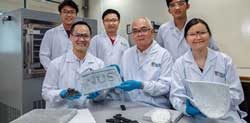
Scientists from the National University of Singapore (NUS) have recently come up with a new, weightless aerogel material from waste tyres. The new aerogels, being highly absorbent, durable, and efficient at trapping heat and sound, could promote more extensive use of waste tyres and offer an eco-friendly alternative to recycle used rubber. (A typical aerogel is a synthetic porous ultralight solid with extremely low density and extremely low thermal conductivity.
According to the Head at NUS’s Department of Engineering, Associate Professor Duong Hai-Minh, the rate of recycling worldwide remains low because processing used rubber is costly, energy-intensive and lacks monetary incentive. His team, however, opted to create rubber aerogels from waste tyres because they are a cheap and abundant resource.
The NUS scientists started with recycling car tyre fibres that were then soaked in water and a minimal amount of chemical cross-linkers. Next, the mixture of rubber fibres and eco-friendly solvents was dispersed uniformly using an agitator for 20 minutes. The resulting smooth suspension gel was then freeze-dried at minus 50 degrees Celsius for up to 12 hours to produce the rubber aerogels.
“The fabrication process is simple, cost-effective and eco-friendly. The entire production process can be done in less than 14 hours, and costs less than S$10 (US$6.91) to produce a sheet of rubber aerogel one sqm in size and 1cm thick. The process can also be easily scaled up for mass production.
This makes rubber aerogels a commercially attractive product.”
